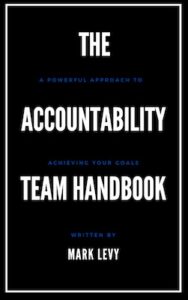Sponsored by ATH

The only book on accountability that you’ll ever need.
My long-time friend Mark Levy is an accountability guru. I’m a very productive chap, but I’ve never been more productive and had a more balanced life than when I started following his lead.
Find out for yourself how to unlock the power of accountability.
👉🏼👉🏼 Buy the book now

The Trojan War was in its 10th year when those rascally Greeks rolled up a wooden horse to the gates of Troy. It was a gift of surrender, or so the gift card said.
It all seemed a bit odd to the Trojans. I mean, the Greeks were fighting a long and brutal fight and then, just like that, they gave up and surrendered.
Who does that?!
But hey, a gift is a gift. Sure, a large wooden horse is a really odd choice for a present. But the Trojans aren’t heartless, they recognize that it’s the thought that counts.
So they wheel the big wooden horse inside of their walls and leave it there in the courtyard.
We all know the rest.
Later that night, while the Trojans were snoring soundly on their floor mats, the Greeks snuck out of the wooden horse, unlocked the gates of the city walls, and allowed their compadres to wallop the Trojans in a final victory.
The Trojans were set up to fail.
That was seven thousand years ago. Since then, leaders have been acting like the Greeks and Trojans on a regular basis.

It’s Not About The Horse
The Trojan horse switcheroo wasn’t the first time that somebody presented a wonderful gift to another simply to set them up for failure, but it certainly is the best example that involves a wooden animal.
There are a couple of important elements to this story, none of which have to do with the horse.
First, the Greeks. They fought a strong fight for ten years and then, all of a sudden did an about-face. That shouldn’t have been trusted.
Secondly, the Trojans. They noticed a change in behavior and mistook it for a gift.
Ok, now is the time for the self-awareness part of this article to kick in.

The Beginning
It can be a laborious process to find and hire new people. Once you hire them, though, it’s all excitement and joy jumping. Bringing new people into a company allows you to get a new outlook from fresh faces which leads to more growth. Those are all pretty good things.
If you’re like me, you probably work hard to help your new employees succeed. Yay you.
But the reality is that there’s still a lot of unknown when you hire somebody new. After all, you don’t really know them beyond whatever positive impression you got from the interview process.
Similarly, they don’t really know the internal workings of the company beyond the hyped-up version they made up in their heads.
After some time on the job, both parties begin seeing the faults in the other. The honeymoon period is over and the iceberg of ignorance floats in.
The Beginning of the End
In most cases, everything works out just fine. We all have our own faults and working together is about accepting each other for theirs. But in some instances, things go afoul with that leader-employee relationship.
It could happen 10 months into the job or a Trojan War-like 10 years later. Either way, there’s an event that triggers a sudden change: a missed deadline, a failed project, or the way the employee spoke at a meeting – it could be anything.
Whatever triggered the manager, it caused them to immediately change their behavior towards the employee. One day the boss is all sympatico with the person and the next day the boss has emotionally fled town like a Greek army after building a gift horse.
This is the beginning of the end.

Set Up To Fail
In these scenarios where the employee is set up to fail, the boss will begin acting in ways that silo the employee. They will leave the employee out of the decision-making process. They won’t communicate directly with the employee unless they are required to. Often they don’t even give the employee all the information they need to complete their job.
You’ve seen people get set up to fail before, right?
Inevitably the employee fails. They either quit or get fired.
“Thank G-d they’re finally gone,” the boss says in relief.
Too bad the boss is wrong.
The Failure
Your goal, as a great leader, is to set your employees up to succeed. Your job is to help them become great leaders themselves.
The scenario above describes how, all too often, leaders set up their employees to fail. And when the employee does fail, the leader rarely looks at their own behavior and simply blames the employee.
I’m not saying that the employee was the right fit for the company, what I’m saying is that the leader gave them no choice but to fail. They created a lose-lose scenario and ensured it was a bad fit.
Setting employees up to fail is a common occurrence. It happens at all size companies and at all levels – sometimes it’s purposeful and sometimes it’s done subconsciously.
Either way, it is behavior that is uncharacteristic of successful leaders.
If your employees are set up to fail, then your leadership is set up to fail.
I’ve coached many leaders through this scenario because it’s a critical one to overcome.
Yes, the Greeks won the war by suddenly changing their attitude and setting the Trojans up for failure. But they would’ve lost in business leadership with that tactic.
A Somewhat Relevant Quote
“Some people create their own storms then get upset when it rains.“
Unknown, probably a meteorologist
Random News
Stare Master – They don’t call him “Eyesore” for nothing
Shark Bites – Baby shark do-do-da-do-do-don’t
Breathe Free – Every state ranked by air quality
Party in Back – It’s the 2023 Mullet Championships
